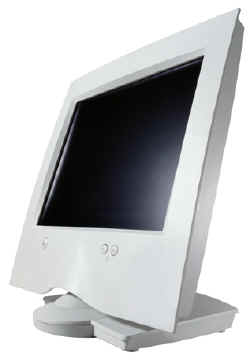Electrons Jump More Easily

Physicists have reduced the electric field strength required to remove an electron from a metal surface by more than a factor of 10. Although the effect was demonstrated experimentally earlier this year by the same team, the standard theory of electron emission could not account for the electron’s surprising talent for escape. Now, in the 24 July PRL, the researchers report a new theoretical explanation. The advance could lead very soon to more cost-effective flat panel computer displays.
As most laptop owners realize, the liquid crystal displays used in current flat panel displays are difficult to see from an angle. Field emission displays, on the other hand, produce high-quality graphics that look the same from all directions. These panels are made from millions of nanometer-scale needles. The screen is illuminated when a strong electric field yanks electrons from the sharp needle tips like tiny bolts of lightning. But this design is extremely expensive for two reasons: First, a powerful electric field is needed to pull the electrons free, which requires high-voltage circuits. Second, the needle shapes must be extremely uniform, or else only the sharpest needles will emit electrons.
Despite their drawbacks, needles were the only way to go until Vu Thien Binh and his collaborators at the University of Lyon in Villeurbanne, France, laid a 5-nm-thick layer of semiconducting material over a platinum sheet. They discovered that the electric field required to produce a steady electron current from the coated sheet dropped by more than ten times because the electron escape barrier fell from about 5 to 0.7 eV. And since the current flows from a flat surface, there is no need to fabricate uniformly sharp tips. “Now we only need conventional two-dimensional deposition, which is much easier,” says Vu Thien. And much cheaper. But they still didn’t understand why the ultrathin semiconducting (UTSC) layer helped electrons escape from the metal.
Now, a computational model of the UTSC layer’s quantum energy levels built by Vu Thien and Christophe Adressi of the University of Franche-Comté in Bescançon, France, has provided an explanation. When there is no applied field, electrons in the metal layer fill a sea of quantum states up to the metal’s so-called Fermi level. To penetrate the UTSC layer above the metal, electrons have to jump 0.7 eV to a slightly higher level and then climb another 4 to 5 eV to completely escape the UTSC layer. But when an electric field is applied, a few electrons jump to the UTSC layer and create an additional electric field that “bends” the UTSC quantum levels to lower energies, creating a kind of potential energy bowl. Pulled by the electric field, electrons flow from the metal into this bowl. Once the bowl is filled, the electrons spill into the vacuum.
“So far, it is the only model that qualitatively explains the observed effects, and that is what makes it exciting,” says Henryk Birecki of Hewlett-Packard in Palo Alto, California. Vu Thien is now working to turn his idea into a commercially viable product, which he hopes will hit the market in less than two years.
–Mark Sincell
Mark Sincell is a freelance science writer based in Houston, TX.


